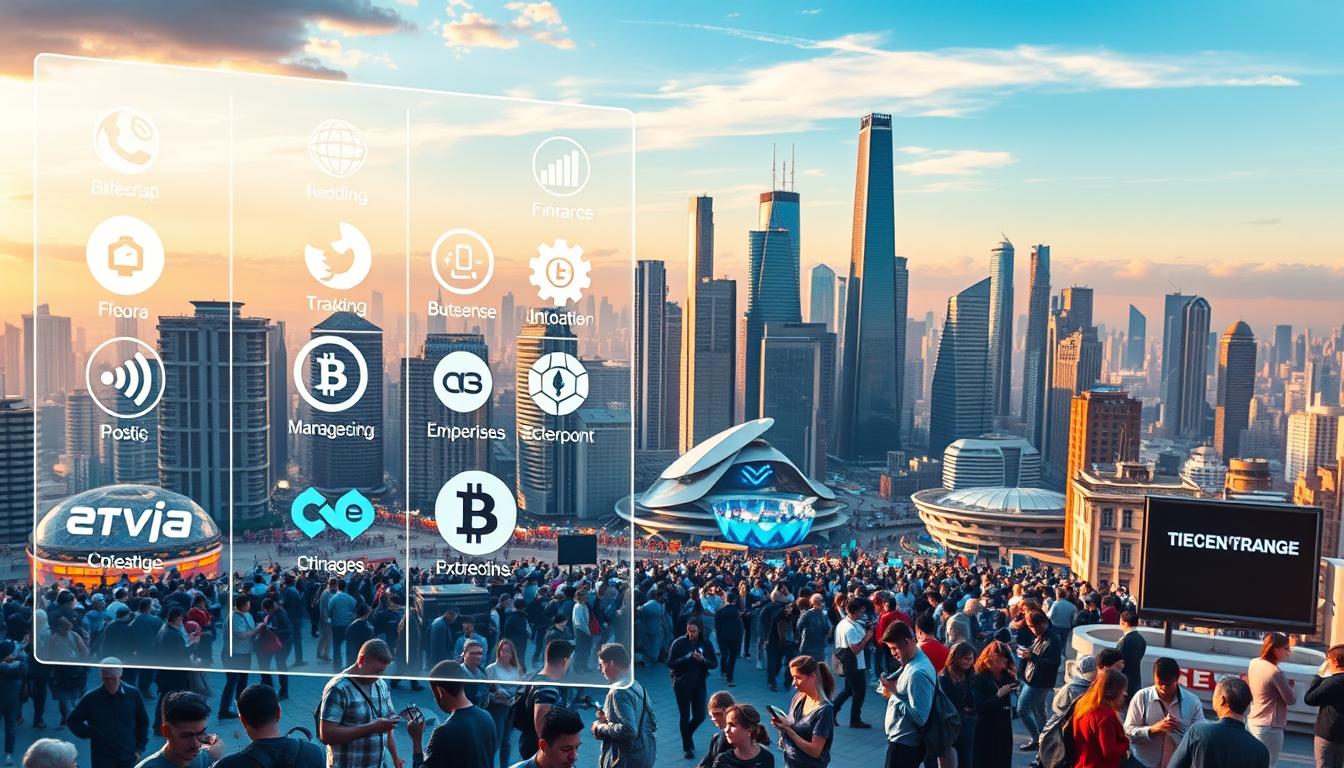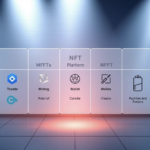Now Reading: Explore the World of Virtual Land Ownership
- 01
Explore the World of Virtual Land Ownership
Explore the World of Virtual Land Ownership
Imagine owning property that exists beyond physical borders – digital spaces where creativity meets commerce. This emerging frontier blends gaming environments with blockchain-powered economies, creating opportunities for users to build, trade, and connect. Digital parcels now function like traditional real estate, complete with verifiable ownership records and thriving marketplaces.

The concept gained mainstream attention when tech giants like Meta invested billions in immersive platforms. Corporations such as PricewaterhouseCoopers and artists like Snoop Dogg have already claimed their stakes. These spaces aren’t just for entertainment – they host events, stores, and collaborative workspaces.
Blockchain technology ensures each transaction remains secure and transparent. Unlike physical property, these assets can evolve rapidly based on user interactions. This shift redefines how we perceive value in interconnected digital worlds.
Key Takeaways
- Digital deeds use blockchain for secure ownership verification
- Meta’s investments accelerated mainstream adoption
- Celebrities and corporations actively participate in this economy
- Virtual spaces host commercial and social activities
- Markets fluctuate based on platform popularity and user engagement
Understanding the Metaverse and Its Impact on Real Estate
Tech giants are racing to build immersive worlds where users live, work, and play in real time. This network of interconnected digital spaces – the metaverse – combines gaming, social media, and commerce into persistent 3D environments. Unlike traditional online platforms, these worlds let people interact through avatars, attend events, and even purchase property.

What Is the Metaverse?
The metaverse isn’t one app or game. It’s a collective space powered by virtual reality (VR) and augmented reality (AR) technologies. Companies like Meta and Microsoft invest billions to create lifelike experiences accessible through headsets or screens. Users can design stores, host concerts, or collaborate in offices that exist only in code.
Digital vs. Physical Property Dynamics
Physical real estate faces location limits and zoning laws. Digital plots in the metaverse operate differently. Developers can expand worlds infinitely, while blockchain technology ensures secure ownership records. Transactions occur instantly using cryptocurrency, and parcels often gain value based on platform traffic. Some early adopters report significant returns through strategic purchases near popular virtual landmarks.
These environments evolve faster than brick-and-mortar spaces. A shopping district can transform into a concert venue overnight. This flexibility creates unique opportunities for brands and creators to experiment with engaging experiences that blur digital and physical boundaries.
Virtual Land Ownership: The Digital Real Estate Paradigm
Digital deeds powered by blockchain are reshaping property rights in immersive environments. This system replaces paper contracts with tamper-proof tokens, enabling users to claim, trade, and develop spaces across decentralized platforms. NFTs serve as the backbone of this ecosystem, ensuring every transaction leaves an indelible mark on distributed ledgers.
The Role of NFTs in Securing Ownership
Non-fungible tokens act as unforgeable certificates for digital plots. Each NFT contains metadata confirming a parcel’s coordinates, size, and transaction history. Unlike physical deeds, these tokens update automatically when properties change hands through strategic acquisitions or sales.

This technology prevents duplicate claims and fraud. Artists and developers use NFTs to monetize creations tied to specific locations, from virtual galleries to interactive ad spaces. The system’s transparency builds trust among investors navigating this nascent market.
Blockchain Technology and Transaction Transparency
Every property transfer gets recorded across multiple nodes in real time. Smart contracts execute deals without brokers, slashing paperwork and fees. Buyers verify a parcel’s authenticity by tracing its blockchain history – a process taking seconds versus weeks with traditional real estate.
Platforms like Decentraland and The Sandbox use this framework to power their economies. As traffic grows on these platforms, blockchain’s immutable records become critical for resolving disputes and maintaining market integrity. This infrastructure supports valuations exceeding $1 million for prime digital locations.
Navigating the Purchase and Sale of Virtual Land
Acquiring property in digital worlds requires understanding modern tools and marketplaces. Start by preparing a secure digital wallet compatible with your chosen platform. This wallet stores both cryptocurrencies and proof of your acquisitions.
Setting Up a Digital Wallet and Cryptocurrency Essentials
Popular platforms like Decentraland and The Sandbox require specific coins – MANA and SAND respectively. Buy these through exchanges like Coinbase or Binance. Transfer funds to your wallet before browsing available plots.
Evaluating Resale Platforms and Market History
Third-party sites like OpenSea.io show pricing trends and recent sales. Check traffic metrics for different areas – parcels near digital landmarks often appreciate faster. Compare sizes, locations, and development potential using historical data.
Completing a transaction takes seconds once your wallet connects. Click “Buy,” confirm with your password, and ownership updates instantly on the blockchain. Sellers list properties through similar interfaces, setting prices based on demand and platform activity.
Always verify wallet compatibility and gas fees before finalizing deals. Successful investors track platform updates and emerging hotspots to maximize returns in this fast-moving market.
Investment Insights: Strategies for Virtual and Real-World Real Estate
Modern investors face a unique choice: allocate funds to physical buildings or digital plots. Both markets share core principles like location value and scarcity but operate under vastly different rules. Understanding these contrasts helps build balanced portfolios across emerging and established asset classes.

Comparing Traditional Real Estate with Digital Investments
Physical properties require months for purchases and permits. Digital transactions settle in seconds using blockchain. Construction crews and zoning boards give way to instant 3D modeling tools. This speed enables rapid portfolio adjustments impossible in the real world.
Market stability differs sharply. Established neighborhoods have predictable growth curves, while digital plots swing with platform popularity. Top metaverse locations now rival Manhattan storefronts for brand visibility. However, their values can shift overnight based on user trends.
Diversification and Risk Management in the Metaverse
Spread investments across multiple platforms to reduce exposure to single-platform crashes. Allocate only 5-15% of your portfolio to digital assets initially. Focus on parcels near event hubs or collaboration spaces – these areas attract consistent traffic.
Leasing digital storefronts to brands creates steady income streams. Advertising deals and sponsored events add revenue layers. Major companies like Nike and Gucci pay premium rates for high-visibility spaces, mirroring real-world retail strategies.
Always research platform roadmaps before buying. Early adopters profit most when user bases grow, but thorough due diligence remains essential in this speculative market.
Opportunities for Growth: Developing and Monetizing Virtual Spaces
Digital property development unlocks unprecedented revenue streams in immersive environments. Creators transform blank plots into thriving destinations, blending commerce with community-driven experiences. Brands and individuals alike leverage these spaces to engage global audiences without geographic limits.
Innovative Uses for Virtual Land and Customization Ideas
Sportswear giants like Nike have built interactive stores where avatars try digital sneakers. Music labels host live concerts in custom-built arenas, selling exclusive merchandise. One investor paid $450,000 for a plot adjacent to a celebrity’s NFT mansion, betting on foot traffic boosting value.
Developers create multi-purpose venues that shift functions daily – a shopping mall by morning becomes a gaming arena by night. Leasing options let owners earn passive income while brands test pop-up campaigns. Admission fees for exclusive events add another revenue layer.
Top strategies for maximizing returns:
- Design spaces near high-traffic hubs like virtual stadiums
- Partner with influencers for co-branded experiences
- Implement tiered access systems for premium content
These environments enable rapid experimentation. A user can prototype a luxury home today and pivot to a theme park tomorrow. Major platforms report 300% growth in developer tools usage, signaling rising demand for customized spaces.
Looking Ahead: Future Perspectives on Digital Land Investments
Digital territories are reshaping global commerce and social interaction. As blockchain technology matures, these assets could become foundational to the metaverse economy, blending work, entertainment, and commerce in persistent 3D environments. Early investors see potential parallels to the internet’s formative years – but with faster adoption curves.
Governance remains the critical challenge. International bodies like the IMF are exploring frameworks to manage disputes and taxation across decentralized platforms. Some propose treaty models similar to maritime laws, ensuring fair access while protecting creator rights. These systems must balance innovation with user protections as transactions multiply.
Platform-dependent risks persist, but diversification strategies help. Savvy buyers spread holdings across multiple metaverse ecosystems and combine them with crypto-backed investments for stability. As augmented reality hardware improves, prime digital properties near event hubs may rival physical locations in value.
The next decade will test whether these assets transition from speculative bets to mainstream portfolio staples. Success hinges on solving scalability issues and creating cross-platform standards. Those who adapt to this evolving landscape could shape tomorrow’s economic infrastructure.
FAQ
How does the metaverse redefine property ownership?
The metaverse uses blockchain to authenticate unique digital assets, allowing users to buy, sell, or lease spaces. Platforms like Decentraland and The Sandbox use NFTs to prove ownership, similar to deeds in physical real estate.
Why are NFTs critical for securing digital assets?
NFTs act as tamper-proof certificates stored on networks like Ethereum. They verify authenticity and track transaction history, ensuring only one person holds rights to a specific plot or item.
What tools do I need to buy a plot in the metaverse?
You’ll need a crypto wallet (e.g., MetaMask) and cryptocurrency like ETH or MANA. Platforms such as OpenSea or Rarible let users browse listings and complete purchases securely.
How do digital investments compare to traditional real estate?
Digital assets offer faster transactions and lower entry costs but lack physical utility. Unlike brick-and-mortar properties, their value depends on platform popularity and user engagement.
Can I monetize my metaverse space?
Yes. Owners host events, build games, or rent areas for ads. Brands like Nike and Gucci lease spaces for virtual stores, creating revenue streams through partnerships or tokenized rewards.
What risks come with investing in the metaverse?
Market volatility, platform dependency, and regulatory uncertainty are key risks. Diversifying across platforms like Somnium Space and monitoring trends helps mitigate potential losses.
How does blockchain ensure transparent transactions?
Every sale or transfer is recorded on public ledgers, visible to all users. This eliminates fraud risks and provides a clear history of ownership changes for assets like Cryptovoxels parcels.
Are digital properties influenced by real-world trends?
Yes. Interest rates, tech advancements (e.g., VR headsets), and corporate adoption (like Walmart’s virtual showrooms) impact demand and pricing in platforms such as Spatial.















